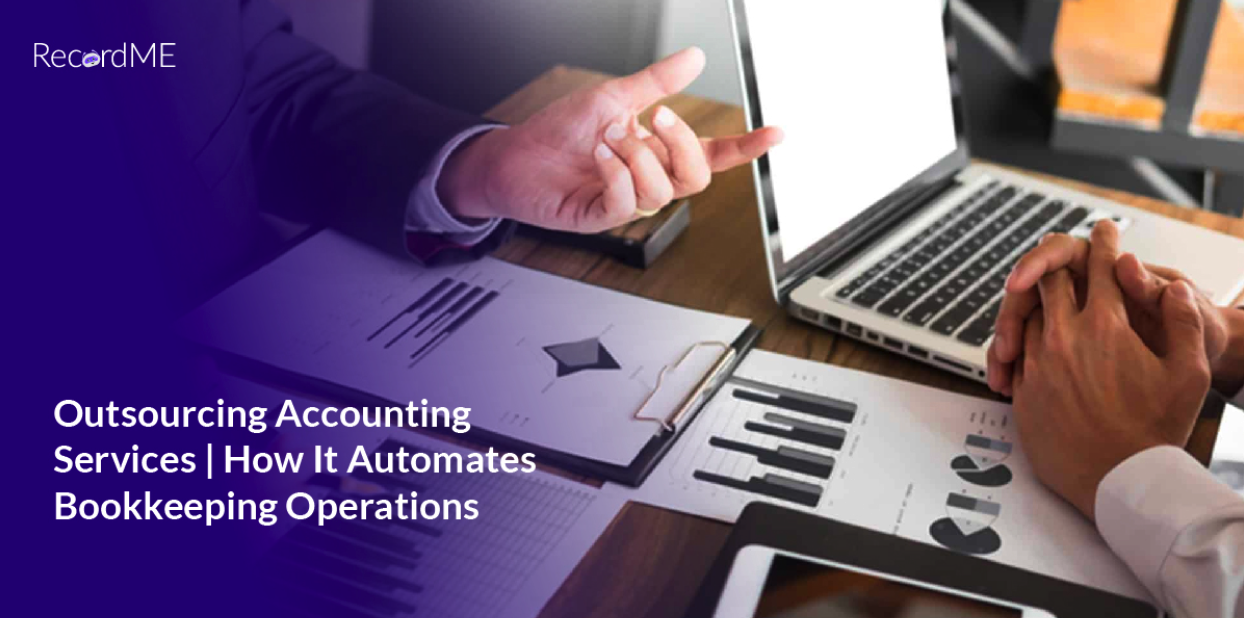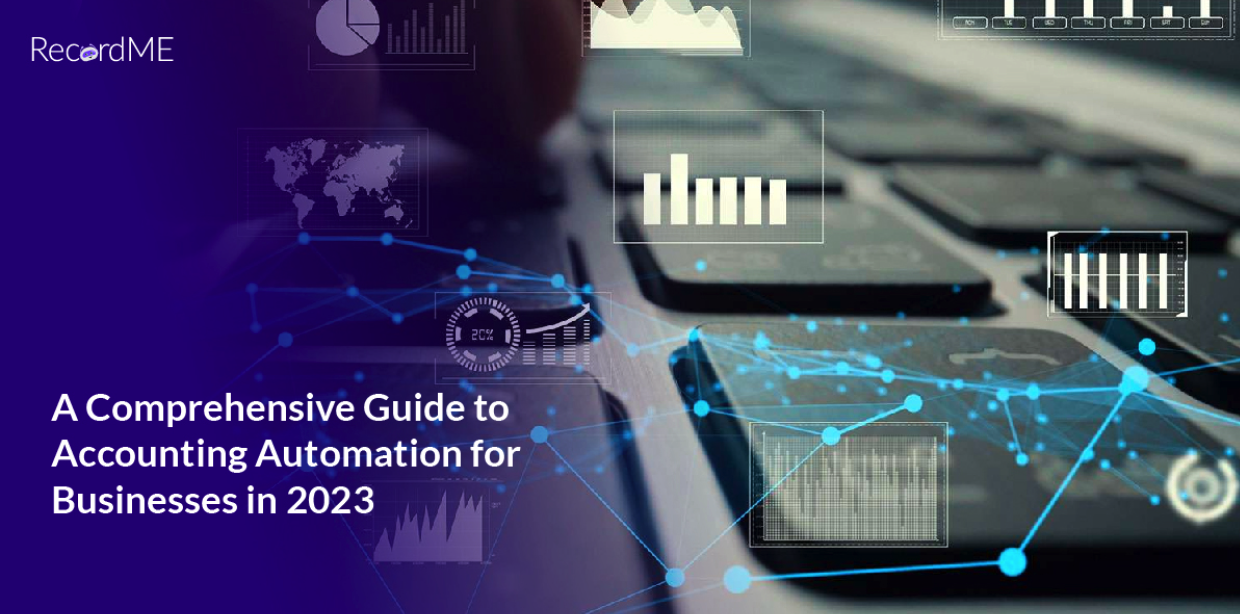Accounting Automation | How AI Transforms Financial Tasks

In This Post
Accounting procedures done manually are notably time-consuming. Core finance activities like payroll, accounts payable, and tax compliance are handled by spreadsheets. However, the procedures that could be finished in a matter of minutes or seconds instead take hours or even days. Furthermore, human error can occur at any stage of the manual process, resulting in extra expenses, delays, and inconvenience.
Businesses may significantly reduce the possibility of human error whilst speeding up operations by implementing an accounting automation solution. Moreover, according to the survey, the accounting software market is expected to reach $416.23 million by 2024. This article will discuss the different steps of accounting automation to streamline a business’s financial tasks.
What Is Accounting Process Automation?
AI-powered accounting services streamline financial procedures using technology and software. Account reconciliation, financial data changes, and filing of statements are done utilising automated accounting software. Automating accounting functions doesn’t replace human intervention; it only frees up the accounting team to focus on high-value duties.
Recent developments in Robotic Process Automation (RPA) and Artificial Intelligence (AI) have greatly improved accounting systems. Artificial intelligence could soon enable accounting automation software to perform all tasks, including tracking and recording data. According to recent research, 58% of accountants think technology boosts productivity. This allows businesses to free up analysts’ time from mundane duties like data input and calculations so that they may concentrate on strategic initiatives.
Automation redefines accounting operations. However, 65% of respondents said that automating processes and workflows are the two most essential factors for accountants in the next five years. Modern solutions are error-free and require little human intervention. Team members can focus on critical activities like budgeting and investment planning.
Accounting Tasks Business Can Automate Now
Every company is in a unique starting point and is implementing accounting automation at a different pace. However, various organisations will take an organised strategy, first automating only the most essential tasks.
Every business today can begin automating the following seven accounting processes immediately.
-
Accounts Payable
Automating accounts payable streamlines the payment process. It facilitates accurate invoicing and timely payments to suppliers by accounting departments. Another benefit of an accounting automation solution is that it helps catch potentially fraudulent invoices before they go unnoticed.
-
Accounts Receivable
By automating accounts receivable, businesses may better handle their cash flow, increase invoice accuracy, and decrease processing expenses. From arranging when invoices will be sent to tracking late payments, there are numerous automation points across AR.
-
Payroll
As a company expands, more expectations are placed on the accounting department, processing payroll manually becomes a significant time waste. Payroll processing automation ensures workers are paid on time and staff members never forget to submit a payroll report.
-
Month-End Financial Closes
One of the most challenging tasks for finance departments is the monthly financial close, which is essential to the smooth operation of any firm. There is increasing pressure on accountants to speed up their month-end closes, which eventually leads to doubts about the reliability of the final statistics. Accounting automation reduces the stress associated with meeting tight deadlines without compromising the integrity of financial records.
-
Procurement
Historically, obtaining goods and services from outside vendors has required a significant amount of documentation, which numerous stakeholders had to examine and handle manually. Businesses can reduce their procurement process’s time and expense significantly by automating procedures like purchase order administration. Furthermore, it has no adverse effects on their supplier relationships or compromises the integrity of their operations.
-
Expense Reports
Cost reports are an unavoidable burden. In many companies, employees must print expense reports as Excel sheets, attach receipts to forms manually, and submit packets to accounting for approval. Employees can digitally submit expense reports to the accounting department, eliminating administrative complexity and paper waste.
-
Sales Order Process
To guarantee that customer orders are processed, shipped on schedule, and at the correct cost, a transparent order processing system is essential. By automating every stage of the sales order process, companies can guarantee that their customer service meets their expectations every time with financial accounting automation software.
What are the 6 Steps to Implement the Accounting Automation Process?
Purchasing some AI software isn’t the only way to automate the accounting process. Accounting Process Automation (APA) software calls for a systematic strategy that begins with identifying manual processes, determining their constituent parts, and then automating each of those parts. It is essential to test the automated processes to ensure they perform as expected.
Here are six methods by which businesses might improve their bookkeeping processes.

1) Analyse Current Accounting Tasks
Not all bookkeeping tasks are adaptable to computerisation, despite common viewpoints. Companies need to review their current operations to figure out what kind of software they actually require.
When assessing your current procedures, think about the following:
- Do you routinely perform the same accounting procedures?
- Does this work include communication or original thought?
- How do you handle your accounting needs at the moment, and what methods do you use?
- What is the breakdown of time spent on each activity?
- Find mistakes in the data frequently?
Companies must calculate each employee’s gross and net compensation based on hours worked, government investments, and monthly taxes, which take time. They can easily calculate salaries, issue checks, and organise employee information with the help of a payroll management system.
2) Evaluate Existing Technologies
The Account Process Automation (APA) method is software-based. The optimal automation strategy for a company will rely on the accounting technology and software programs it currently uses. However, it checks whether or not these systems can communicate with one another already. Popular cloud-based APA solutions unify a company’s finance processes on a single infrastructure where data is gathered, transferred, and analysed in a standard language.
3) Assign a Project Owner
All of the accounting automation procedures are software-based. However, a human worker is still needed to monitor APA operations to ensure proper functioning and fix any issues that may develop. Incorrect payroll payments may occur because the software relies on rules established by users or the corporate administrator. If the project manager is aware of the situation early on, they can either prevent it from affecting workers or lessen its impact.
4) Streamline Existing Workflows
Accounting automation aims to streamline and improve existing processes. The most effective strategy, however, is to search for ways to automate financial tasks. By analysing current processes, companies can identify weak points and determine the most effective way to carry out tasks using an APA solution.
5) Analyse the Key Elements of Workflow Automation
A business’s workflow can be divided into three categories: triggers, actions, and outcomes. These three components must be specified in great detail to guarantee that workflows automate and provide the desired outcomes every time.
Take into consideration, for example, an easy Purchase Order (PO) approval routine. A new purchase order that a procurement manager submits could be a trigger. This would then cause an action to be initiated, like sending an automated email notifying the appropriate business stakeholder that the purchase order is prepared for approval. The goal is to have a PO approved.
6) Test and Iterate
Businesses can test and iterate to ensure that an accounting automation workflow consistently produces the desired outcomes. A single test run might be sufficient. However, companies perform multiple attempts to identify flaws, particularly when converting manual procedures to automated software.
How Does RecordMe Fit in the Puzzle?
RecordMe is an automated accounting platform that helps business streamlines financial processes. We provide advanced accounting automation that can manage a wide range of financial activities, from invoice and billing creation to payment reimbursements, all while maintaining excellent relations with customers. Moreover, RecordMe collects data from Word Docs, PDFs, and images and transfers it to the accounting software of your choice. We aid businesses in expanding by providing them with efficient, error-free, automated accounting systems.
To improve precision, efficiency, and production while decreasing overhead costs, we take great care to find a balance between human expertise and automation. Still trying to understand how automation can improve your chances of success in the modern world? Talk with us!



